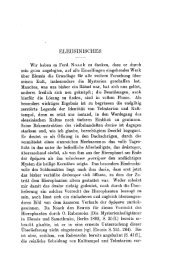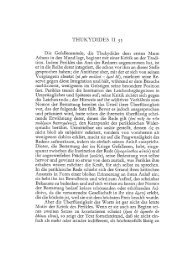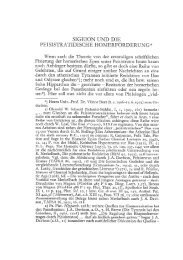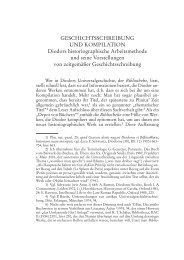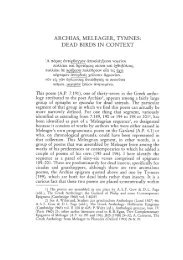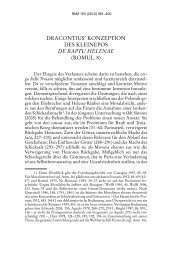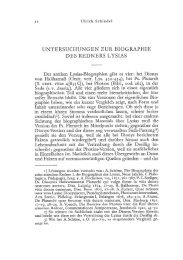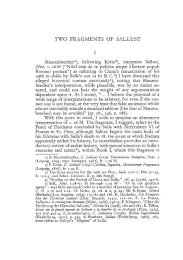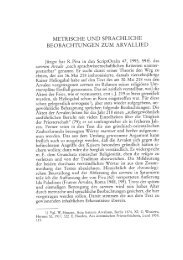APOTELESMATICA 2. (1) 14–140: SOURCES AND MODELS*
APOTELESMATICA 2. (1) 14–140: SOURCES AND MODELS*
APOTELESMATICA 2. (1) 14–140: SOURCES AND MODELS*
Create successful ePaper yourself
Turn your PDF publications into a flip-book with our unique Google optimized e-Paper software.
90 Maria Ypsilanti<br />
20 f.). 50 Pseudo-Manetho also transfers the emphatic and pleonastic<br />
presentation of continuity from the eternal movement of the<br />
stars (oÈran“ ßlkontai pãntÉ ≥mata sunex¢w afie¤, in Aratus), to the<br />
eternal rotation of the world around the axis (Œka dihnek°vw dineÊmenow<br />
oÈk épolÆgei, l. 21), in Aratus described with a simple afi°n.<br />
These Aratean lines are further exploited in another passage of the<br />
Apotelesmatica, <strong>2.</strong> (1) 61–63. Here Pseudo-Manetho presents a<br />
reversal of the image of Aratus, using the latter’s égine›n and the<br />
emphatic reference to the sky (oÈranÚn aÈtÒn) to describe now the<br />
act of the sky which rotates the stars around earth, while in his<br />
model the sky was the object of the rotating force of the axis. 51 On<br />
the level of vocabulary, one can observe that •l¤ssesyai is commonly<br />
employed by Aratus in descriptions of stellar movement. 52<br />
Furthermore •lissÒmenow per‹ xeiª / kapn“ / fÊsaw / d¤naw are epic<br />
formular phrases. 53 The use of the verb’s active form can be seen<br />
within the poet’s characteristic tendency for avoidance of the exact<br />
50) Pseudo-Manetho points out that the axis turns the universe around it<br />
passing, at the same time, through the land and the sea, or being extended across<br />
them (see LSJ s. v. diã A 4), since it is the axis of both earth and universe and its rotating<br />
force affects the whole world (pçn); cf. for instance Posidon. fr. 3c, 29 ff. ≤ g∞<br />
. . . ımÒkentrow m¢n t“ oÈran“ p°lei ka‹ aÈtØ ka‹ ı diÉ aÈt∞w êjvn ka‹ toË oÈranoË<br />
m°sou tetam°now, ı dÉ oÈranÚw perif°retai per¤ te aÈtØn ka‹ per‹ tÚn êjona épÉ<br />
énatol∞w §p‹ tØn dÊsin, sÁn aÈt“ d¢ ofl éplane›w ést°rew ımotaxe›w t“ pÒlƒ, Eust.<br />
Od. 1.17,29 tÚn nohtÚn êjona nooËsi tÚn diå m°shw t∞w g∞w §lhlãmenon . . . per‹ ˜n,<br />
…w ka‹ t“ ÉArãtƒ doke›, oÈranÚw efile›tai. For the axis turning the sky around<br />
it, cf. also Schol. on Arat. 23 periãgei, fhs¤n, ı êjvn tÚn oÈranÒn, Achilles, Eis.<br />
28 (p. 61, l. 4 ff. Maass): »nÒmastai dÉ êjvn diå tÚ per‹ aÈtÚn êgesyai, ka‹<br />
peridine›syai tÚn oÈranÒn. For a transitive use of dineÊesyai, in an active meaning,<br />
cf. Diosc. AP 7.485 peridinÆsasye makr∞w énel¤gmata xa¤thw, “whirl your long<br />
flowing locks” (Paton’s translation, in the Loeb edition). Note the tmesis in the<br />
phrasing of Aratus (per‹ . . . égine›), imitated also by Pseudo-Manetho with his per‹<br />
. . . dineÊmenow. Diã is constructed apo koinou with ga¤hw and pÒntou: similar constructions,<br />
with per¤, occur in book 6 of the same work, ll. 227 f. ˜ssoi dØ xyon¤ƒ te<br />
ka‹ afiputãtƒ per‹ k°ntrƒ / ést°raw eÈergoÁw f«tew beba«taw xousin, ktl., l. 305<br />
tÒssÉ efipΔn ét°knvn te ka‹ ésp°rmvn per‹ fvt«n.<br />
51) For the variants attested from antiquity in regard to the reading oÈranÚn<br />
aÈtÒn of Arat. 23 and a discussion of their possibility of rightness, see Kidd ad loc.<br />
Kidd’s argumentation in favour of oÈranÚn aÈtÒn seems adequate for the acceptance<br />
of this reading. ÉAgine› at verse-end, apart from Arat. 23 where the whole passage<br />
refers, also occurs in the epic, cf. Od. 14.105, 2<strong>2.</strong>198, Hes. Op. 576; also Arat. 38,<br />
356, 623, 666, 79<strong>2.</strong><br />
52) See Kidd on 147.<br />
53) Cf. Il. 1.317, 18.372, 21.11, 2<strong>2.</strong>95; see N. Richardson, The Iliad: A Commentary,<br />
vol. VI: books 21–24 (Cambridge 1993), on 2<strong>2.</strong>95.



